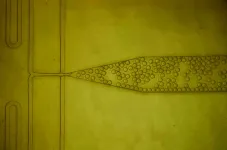(Press-News.org) Americans are drinking more caffeinated beverages than ever before, but Rutgers researchers found one group that tops the charts in caffeine consumption: adult smokers with mental illness.
In a study published online ahead of print in the January issue of the journal Psychiatry Research, Jill M. Williams, director of the division of addiction psychiatry at Rutgers Robert Wood Johnson Medical School, found not only do adult smokers with bipolar disorder and schizophrenia drink the most caffeine, they are at the highest risk of negative health consequences.
“Caffeine is generally considered safe and even has some health benefits,” said Williams. “But we just don't understand the cognitive and psychiatric effects of high caffeine intake, especially among smokers with mental illness.”
Caffeine is one of the most widely used psychoactive drugs in the United States, with the main effects increased alertness, attention and vigilance. While it’s considered safe for most healthy adults to consume up to 400 milligrams of caffeine per day – the equivalent of about four cups of brewed coffee – consuming more than 600 milligrams isn’t recommended and can lead to anxiety, insomnia, excess stomach acid and heartburn.
Little is known about caffeine’s influence on executive functions, such as reasoning and decision making, and the studies that have been done have mostly included healthy adults without mental illness, Williams said. Even less is known about how high caffeine intake may impact psychiatric symptoms or sleep in adults with serious mental illness who smoke.
To address these gaps, Williams and colleagues from the Rutgers Department of Psychology and the University of California San Francisco School of Medicine analyzed data from 248 adult smokers recruited during a previous study. Participants were either outpatient smokers with schizophrenia or bipolar disorder or from a control group with no psychiatric diagnoses. All participants were pack-a-day smokers.
At the beginning of the study, participants completed surveys on smoking history, caffeine use, physical health and psychological symptoms. The researchers also collected blood samples to measure serum caffeine levels.
They found caffeine intake was highest among participants with bipolar disorder, followed by adults with schizophrenia. The control group consumed the least amount of caffeine.
Williams said there are several theories to explain the relationship between caffeine intake and mental illness. One is a well-established association between caffeine and smoking: People with mental illnesses smoke at rates two to three times higher than the general population, and because the tars in cigarette smoke increase the metabolism of caffeine, it takes more caffeine to achieve stimulating effects.
Another theory links high caffeine intake to adenosine receptors and supports a possible self-medication effect among people with mental illness, said Williams. People with mental illnesses also seem to have vulnerabilities to all types of addictive substances, putting them at higher risk for excess intake and more negative consequences. Additionally, the researchers found evidence that mood is linked to caffeine intake, especially bad mood.
Each of these explanations warrants further investigation, Williams said.
“Today, people consume huge amounts of caffeine in more concentrated forms – like energy drinks or double shots of espresso – far more than when our participants were surveyed,” she said. “And yet, the effects of high caffeine intake remain widely understudied. This is particularly true for people with mental illness.”
END
Adult smokers with mental illness consume the most caffeine in the U.S.
Mood, metabolism and self-medication might explain use patterns among this population, according to Rutgers research
2023-02-28
ELSE PRESS RELEASES FROM THIS DATE:
Alternative bladder cancer treatment emerges amid worldwide shortage of standard of care BCG
2023-02-28
An on-going, worldwide shortage of bacillus Calmette-Guérin (BCG) means that many patients with a common and serious type of bladder cancer have limited access to this effective standard of care treatment. But, for the first time in almost 50 years, there appears to be a viable treatment alternative.
A new study from the University of Iowa finds that a safe, inexpensive combo-chemotherapy is better tolerated than BCG and is better at preventing high-grade cancer recurrence in patients with non-muscle invasive ...
Researchers’ model for TV ad scheduling reaps revenue increase for networks
2023-02-28
Whether it’s Flo from Progressive or the Geico gecko, the average TV viewer may not give much thought to commercials outside of whether they’re entertaining or not. However, there is a rather complex science behind what commercials you see and when you see them.
Rensselaer Polytechnic Institute’s Sebastian Souyris, an assistant professor of supply chain and analytics who holds the Dean R. Wellington ’83 Teaching Professorship in Management at the Lally School of Management, along with his ...
Steel was already used in Europe 2900 years ago
2023-02-28
A study by an international and interdisciplinary team headed by Freiburg archaeologist Dr. Ralph Araque Gonzalez from the Faculty of Humanities has proven that steel tools were already in use in Europe around 2900 years ago. Using geochemicalanalyses, the researchers were able to prove that stone stelae on the Iberian peninsula that date back to the Final Bronze Age feature complex engravings that could only have been done using tempered steel. This was backed up by metallographic analyses of an iron chisel from the same period and region (Rocha do Vigio, Portugal, ca. 900 BCE) that showed the necessary carbon content to be proper steel. The result was also confirmed ...
Better metric for prioritizing conservation of “evolutionarily distinctive” species
2023-02-28
An updated metric for prioritizing species’ conservation that incorporates scientific uncertainty and complementarity between species, in addition to extinction risk and evolutionary distinctiveness, is publishing February 28th in the open access journal PLOS Biology, authored by Rikki Gumbs from the Zoological Society of London (ZSL), UK, and colleagues.
In 2007, ZSL established the Evolutionarily Distinct and Globally Endangered (EDGE) metric to prioritise species for conservation based on preserving evolutionary history embodied within endangered species. The approach ...
Parental investment may have aided evolution of larger brains
2023-02-28
A review of evidence from prior research provides new support for the possibility that the evolution of larger brains in some species was enabled through increased energy investment by parents in their offspring. Carel van Schaik of the Max Planck Institute for Animal Behavior in Konstanz, Germany, and colleagues present their arguments in a paper publishing February 28th in the open access journal PLOS Biology.
Between different species, larger relative brain size is associated with cognitive benefits that favor survival. However, larger brains ...
Profiling abortions in low- and middle-income countries
2023-02-28
Multiple factors including a women’s age, marriage status, education and how many living children she has, are associated with pregnancy termination in low- and middle-income countries, according to a new study published this week in the open-access journal PLOS Global Public Health by Djibril Ba of Penn State College of Medicine, US, and colleagues.
In low- and middle-income countries (LMICs), a woman’s decision to terminate a pregnancy is often impacted by a patriarchal structure of society, restrictive abortion laws, cultural and religious beliefs and economic factors. About 45% ...
Hollings researchers develop small molecule to stimulate natural killer cells against neuroblastoma
2023-02-28
An MUSC Hollings Cancer Center research team has created what team members believe to be among the first small molecules designed to stimulate immune cells to fight cancer. More importantly, these compounds inhibit a specific enzyme that hasn’t been targeted with small molecules for the treatment of cancer.
Small molecules are, quite literally, small. They’re hundreds of times smaller than monoclonal antibodies currently used in therapy, and they’re also structurally much simpler. Because of their low molecular mass, they are much more likely to enter cells. Aspirin, for example, is a small molecule ...
'Informal carers’ experienced mental health decline ‘akin to divorce’ during COVID lockdowns
2023-02-28
People who became carers during Covid-19 by helping family members, friends or neighbours in need experienced a sharp decline in their own mental health, new research from Lancaster University reveals.
Using the General Health Questionnaire (GHQ) scale – a psychometrically validated and widely used index of psychological distress – researchers studied individual responses to the UK Household Longitudinal Study (Understanding Society).
They looked at 4698 participants from a total of 11 surveys - three before COVID-19 and eight collected between April 2020 ...
CU School of Medicine researchers part of national team that identified a new dietary approach to treatment for eosinophilic esophagitis
2023-02-28
Research by a team that includes two faculty members from the University of Colorado School of Medicine may change the treatment paradigm for patients with eosinophilic esophagitis (EoE), an allergic condition that causes chronic inflammation in the esophagus that can lead to esophageal narrowing and dysfunction.
Glenn Furuta, MD, professor of pediatric gastroenterology, hepatology, and nutrition, and Paul Menard-Katcher, MD, associate professor of gastroenterology, helped lead the National Institutes of Health (NIH)-funded, multisite study that shows that a single-food ...
New purification method could make protein drugs cheaper
2023-02-28
CAMBRIDGE, MA -- One of the most expensive steps in manufacturing protein drugs such as antibodies or insulin is the purification step: isolating the protein from the bioreactor used to produce it. This step can account for up to half of the total cost of manufacturing a protein.
In an effort to help reduce those costs, MIT engineers have devised a new way to perform this kind of purification. Their approach, which uses specialized nanoparticles to rapidly crystallize proteins, could help to make protein drugs more affordable and accessible, especially in developing ...
LAST 30 PRESS RELEASES:
This self-powered eye tracker harnesses energy from blinking and is as comfortable as everyday glasses
Adverse prenatal exposures linked to higher rates of mental health issues, brain changes in adolescents
Restoring mitochondria shows promise for treating chronic nerve pain
Nature study identifies a molecular switch that controls transitions between single-celled and multicellular forms
USU chemists' CRISPR discovery could lead to single diagnostic test for COVID, flu, RSV
Early hominins from Morocco reveal an African lineage near the root of Homo sapiens
Small chimps, big risks: What chimps show us about our own behavior
We finally know how the most common types of planets are created
Thirty-year risk of cardiovascular disease among healthy women according to clinical thresholds of lipoprotein(a)
Yoga for opioid withdrawal and autonomic regulation
Gene therapy ‘switch’ may offer non-addictive pain relief
Study shows your genes determine how fast your DNA mutates with age
Common brain parasite can infect your immune cells. Here's why that's probably OK
International experts connect infections and aging through cellular senescence
An AI–DFT integrated framework accelerates materials discovery and design
Twist to reshape, shift to transform: Bilayer structure enables multifunctional imaging
CUNY Graduate Center and its academic partners awarded more than $1M by Google.org to advance statewide AI education through the Empire AI consortium
Mount Sinai Health system receives $8.5 million NIH grant renewal to advance research on long-term outcomes in children with congenital heart disease
Researchers develop treatment for advanced prostate cancer that could eliminate severe side effects
Keck Medicine of USC names Christian Pass chief financial officer
Inflatable fabric robotic arm picks apples
MD Anderson and SOPHiA GENETICS announce strategic collaboration to accelerate AI-driven precision oncology
Oil residues can travel over 5,000 miles on ocean debris, study finds
Korea University researchers discover that cholesterol-lowering drug can overcome chemotherapy resistance in triple-negative breast cancer
Ushikuvirus: A newly discovered giant virus may offer clues to the origin of life
Boosting the cell’s own cleanup
Movement matters: Light activity led to better survival in diabetes, heart, kidney disease
Method developed to identify best treatment combinations for glioblastoma based on unique cellular targets
Self-guided behavioral app helps children with epilepsy sleep earlier
Higher consumption of food preservatives is associated with an increased risk of type 2 diabetes
[Press-News.org] Adult smokers with mental illness consume the most caffeine in the U.S.Mood, metabolism and self-medication might explain use patterns among this population, according to Rutgers research




